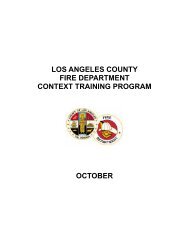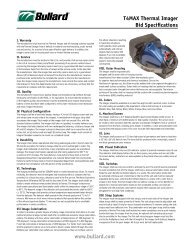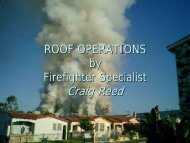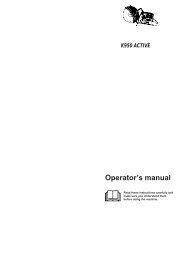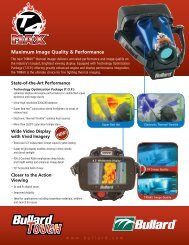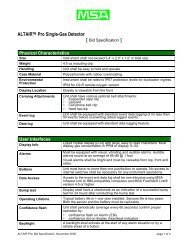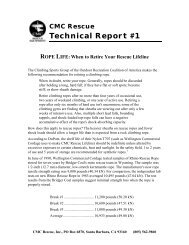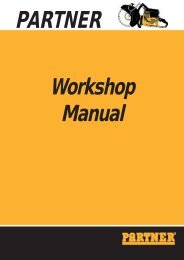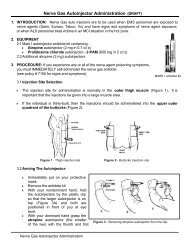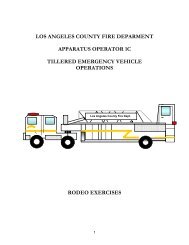Sperian Warrior - Los Angeles County Firefighters Association
Sperian Warrior - Los Angeles County Firefighters Association
Sperian Warrior - Los Angeles County Firefighters Association
Create successful ePaper yourself
Turn your PDF publications into a flip-book with our unique Google optimized e-Paper software.
<strong>County</strong> of <strong>Los</strong> <strong>Angeles</strong> Fire Department<br />
<strong>Warrior</strong> SCBA<br />
Training Program
RESPONSIBILITY<br />
All Personnel shall be capable of performing proper donning and use of a self<br />
contained breathing apparatus as outlined in Volume 10, Chapter 3, Subject 1 and the<br />
SCBA section of the Context Manual. Additionally all personnel shall be proficient with<br />
routine cleaning, daily/weekly testing, and required record keeping “Form 20” of selfcontained<br />
breathing apparatus.<br />
Incident Commanders shall insure that all personnel are properly using self-<br />
contained breathing apparatus during fire fighting, overhaul and salvage operations<br />
and when required for safety and protection as outlined in Volume 10, Chapter 3,<br />
Subject 1.<br />
Station Captains shall insure that all self-contained breathing apparatus are<br />
maintained in a serviceable condition at all times and subordinates adhere to all<br />
requirements outlined in Volume 10, Chapter 3, Subject 1.<br />
Fire Fighter Specialists shall inspect all of the unassigned self-contained<br />
breathing apparatus on all apparatus assigned to their station in addition to<br />
their assigned SCBA daily.<br />
All personnel shall inspect their assigned self-contained breathing apparatus<br />
daily. This responsibility shall not be delegated
POLICY<br />
As there is no way to predetermine all hazardous conditions,<br />
concentrations of toxic materials or percentages of oxygen in the air<br />
during emergency operations. Therefore self-contained breathing<br />
apparatus (SCBA) are required to be worn and used at all times by all<br />
personnel when: (NFPA 1404)<br />
* At the scene of emergency incidents where the atmosphere could be immediately<br />
dangerous to life and health (IDLH) or may become oxygen deficient.<br />
* At the scene of emergency incidents where the atmosphere could be contaminated by toxic<br />
vapors, gases, fumes, mist or dust caused by fire, explosions, leaks, spills, or other means.<br />
* Involved in fire fighting, ventilation, salvage and overhaul operations, or under conditions<br />
involving spills or releases of chemicals or other toxic materials.<br />
* Entering confined spaces that t are oxygen deficient; i or, where smoke, chemicals, toxic<br />
agents, toxic fumes of unknown type gases or vapors are present.<br />
* Required by the Incident Commander.
POLICY<br />
Daily: All personnel shall inspect their assigned SCBA and initial the appropriate<br />
Form 20. This responsibility shall not be delegated. Fire Fighter Specialist shall<br />
inspect all unassigned SCBA’s on all apparatus assigned to their station and initial the<br />
appropriate Form 20.<br />
Weekly: All personnel shall don their SCBA and insure they can maintain a negative<br />
pressure facepiece seal, test proper operation of the first breath on function, manual on<br />
button, bypass valve operation, exhalation valve operation, and shut-off button. When<br />
completed they shall date and print their last name on the appropriate Form 20. This<br />
responsibility shall not be delegated. d The Fire Fighter Specialist shall inspect all<br />
unassigned SCBA’s on all apparatus at their assigned station and complete all entries<br />
on the appropriate Form 20.<br />
After Each Use: All SCBA’s shall be cleaned, tested, and returned to a ready for use<br />
status. Each facepiece shall be cleaned and disinfected.<br />
Air Cylinders: shall be stored, filled, and maintained in a safe manner.
POLICY<br />
All personnel: shall demonstrate proficiency in don a SCBA within a 60-second time<br />
limit annually.<br />
All personnel: shall don a SCBA and conduct a search while in a simulated smoke-filled<br />
atmosphere annually.<br />
All personnel: shall properly connect the Emergency Breathing Safety System and<br />
review its uses and limitations Bi-annually.<br />
All personnel: shall have a quantitative facepiece fit test annually.
SAFETY ISSUE<br />
* Air Cylinders shall not be filled without the proper hydrostatic test identification markings.<br />
The hydrostatic test date shall be checked prior to filling each air cylinder. Any air cylinder<br />
found to be out of hydrostatic date (every 5 years) shall be immediately removed from<br />
service, tagged, and sent to Pacoima SCBA shop to be hydrostatic tested.<br />
* The use of self-contained breathing apparatus for water rescue incidents is -PROHIBITED<br />
* Should a fire fighter find themselves trapped underwater, maneuver to a horizontal face-up<br />
position. This orientation can trigger the SCBA to operate in a pressure demand mode<br />
extending the users available air supply.<br />
* The use of self-contained breathing apparatus does not offer complete protection in<br />
atmospheres containing gases or vapors that are absorbed through the skin, i.e.,<br />
Hydrocyanic Acid (Hydrogen Cyanide) Methyl Bromide. Do not enter these<br />
atmospheres until thoroughly ventilated and approved by hazardous materials<br />
personnel.
* The <strong>Sperian</strong> <strong>Warrior</strong> Self-Contained Breathing<br />
Apparatus is the latest addition to the <strong>County</strong> of <strong>Los</strong><br />
<strong>Angeles</strong> Fire Department’s SCBA inventory. The<br />
<strong>Warrior</strong> SCBA meets all requirements of the National<br />
Institute for Occupational Safety and Health (NIOSH)<br />
in accordance with the requirements of 42 CFR 84,<br />
and the National Fire Protection Administration<br />
(NFPA) 1981 Standard on Open Circuit Self<br />
Contained Breathing Apparatus for Emergency<br />
Services, 2007 Edition.<br />
* The most significant change in the 2007 edition is<br />
the mandatory requirement for all emergency<br />
services SCBA to also be NIOSH certified as a<br />
CBRN SCBA in accordance with the NIOSH<br />
Statement for Standard for NIOSH CBRN SCBA<br />
Testing. This requirement provides respiratory<br />
protection from CBRN terrorism agents (specified<br />
chemicals, biological agents, and radiological<br />
particulates) that could be released as a result of a<br />
terrorism attack.<br />
* Several new features including the Heads Up<br />
Display (HUD), Informational Lighting, Universal Air<br />
Connection (UAC), and Emergency Breathing Safety<br />
System (EBSS) provide an increased level of safety<br />
for the user.
BACKPACK HARNESS AND FRAME<br />
The backpack consists of a lightweight aluminum<br />
backplate with an aluminum hip-plate that both hinges<br />
and swivels on the backplate. The backplate has three<br />
integrated carrying handles with carabineer attachment<br />
points. Each attachment point is rated to 1,000 pounds.<br />
Th t i l t l b d h dj t t i t th t ll<br />
The stainless steel band has adjustment points that allow<br />
for the use of 30-minute, 45-minute or 60-minute air<br />
cylinders.
BACKPACK HARNESS AND FRAME<br />
A reflective strip will be adhered the center section of the<br />
stainless steel band. A color coded system will allow for<br />
general identification of each SCBA assigned<br />
Black<br />
Red<br />
Orange<br />
Blue<br />
Green<br />
First Line Apparatus<br />
Reserve Apparatus<br />
Battalion Spare<br />
Training<br />
SCBA Repair Shop
BACKPACK HARNESS AND FRAME<br />
Designed for a secure, stable fit, with weight<br />
concentrated at the hips, the straps are made Kevlar and<br />
incorporate a metal automotive-style waist buckle. The<br />
waist straps adjust from both sides by pulling on the<br />
yellow tabs keeping the SCBA centered during donning.<br />
A regulator belt clip is attached to the left side waist strap<br />
for storage of the second stage regulator. The regulator<br />
belt clip is designed to keep the second stage regulator<br />
clean and secure until it is attached to the facepiece.<br />
The shoulder straps adjust by pulling on the gray tabs<br />
and maintain there adjusted position using an alligator<br />
type clip.
BACKPACK HARNESS AND FRAME<br />
The intermediate pressure hose is routed over the left<br />
shoulder and incorporates the electrical/pneumatic<br />
connector.<br />
This connection can only be made in the correct<br />
orientation completing the air supply to the second stage<br />
regulator and the electronics required for the Heads-Up<br />
Display. The quick connect fittings employ a push/pull<br />
release to prevent accidental disconnection. The male<br />
connection has to be pushed into the female fitting and<br />
the sleeve on the female fitting pulled back to allow<br />
separation.
BACKPACK HARNESS AND FRAME<br />
Located on the lower right side of the backpack is the<br />
battery compartment that houses four C size batteries.<br />
All electronics are supplied by these batteries except the<br />
Voice Amplifier.
BACKPACK HARNESS AND FRAME<br />
Amber LED’s on the PASS Device and the Backpack act<br />
as a battery status indicator. The amber LED’s will flash<br />
once every 10 seconds to indicate a usable battery<br />
condition. The amber LED’s will flash every 2 seconds to<br />
indicate a low battery condition.
AIR CYLINDER<br />
A 45-minute (66 cubic foot – 1800 liter) air cylinder will be the standard<br />
issue for the <strong>Warrior</strong> SCBA. The air cylinder is of composite construction<br />
with an aluminum liner overwrapped by a carbon fiber. The composite<br />
construction offers a significant weight savings compared to older hoopwrapped<br />
designs. Attention to the appropriate handling of composite<br />
air cylinders shall be maintained. Composite air cylinders will not<br />
withstand the abusive treatment that the aluminum hoop-wrapped air<br />
cylinders could.<br />
When placing an SCBA in service, FULLY OPEN the air cylinder valve.<br />
Partial opening can cause the loss of breathing air as cylinder pressure<br />
decreases. The air cylinder valve does not incorporate a locking<br />
sleeve. The valve knob is designed not to close under normal<br />
operations.<br />
All air cylinders intended for use with the <strong>Warrior</strong> SCBA’s have a maximum<br />
fill capacity 4500 psi. Air cylinders less than 4000 psi shall be exchanged<br />
for a full air cylinder.
AIR CYLINDER<br />
All 45-minute air cylinders for use in the field have a two inch luminescent band at the<br />
upper end of the cylinder. Printed three times within the band is the <strong>Los</strong> <strong>Angeles</strong> <strong>County</strong>’s<br />
three letter designator, LAC. The color of the letters indicates the date of manufacture<br />
and original hydrostatic test. The color rotation will repeat every five years as hydrostatic<br />
testing on carbon-fiber air cylinders is required every five-years.<br />
Year of Purchase Color 1 st Hydro 2 nd Hydro 3 rd Hydro<br />
2008 Black 2008 2013 2018<br />
2009 Red 2009 2014 2019<br />
2010 Blue 2010 2015 2020<br />
2011 Yellow 2011 2016 2021<br />
2012 Green 2012 2017 2022
FIRST-STAGE REGULATOR<br />
The first-stage regulator is housed and protected within<br />
the backpack assembly. It connects to the air cylinder<br />
valve using a high pressure hose and a large, easy-togrip<br />
stainless steel hand wheel. The stainless steel<br />
hand wheel provides a positive connection reducing the<br />
risk of cross threading or thread damage. The first stage<br />
regulator lowers air cylinder pressure to approximately<br />
115 psi, which is supplied to the second stage regulator<br />
via the intermediate pressure hose. A relief valve<br />
activates to protect the system should the regulator<br />
pressure exceed 200 to 225 psi.<br />
Ahi h ti f th HUD t d<br />
A high-pressure connection for the HUD transducer,<br />
UAC, and the remote Pressure Gauge/PASS Alarm on<br />
the right shoulder are all housed and protected within the<br />
backpack assembly.
LOW AIR ALARM<br />
The integrated low air warning alarm emits an audiblewarbling<br />
whistle when the air cylinder pressure reaches<br />
1035 to 1215 psi. (23 to 27 percent of the rated capacity<br />
of fthe air cylinder) The low air-warning i whistle will operate<br />
until air cylinder pressure drops below 200 psi. The<br />
whistle is located in the upper left corner of the backpack<br />
and is protected by the thermal and impact resistant<br />
enclosure.
AIR PRESSURE GAUGE/PASS ALARM<br />
A high pressure air hose is routed over the right shoulder strap<br />
and attach to the Air Pressure Gauge/PASS Alarm assembly.<br />
The gauge is luminescent for low light viewing and indicates<br />
the quantity of air remaining in the air cylinder once the air<br />
cylinder valve is opened. Air pressure is illustrated t from full<br />
“F” to empty “E” using quarter increments “¼ ½ ¾” similar to a<br />
fuel gauge on a vehicle.<br />
Opening the air cylinder valve arms the PASS device as air<br />
pressurizes the system. An ascending tone and alternating<br />
green flashing LED lights indicate activation. The PASS device<br />
can be manually triggered to full alert by depressing and<br />
holding the red alarm button for 1 to 2 seconds.<br />
Once the PASS reaches full alert, it can only be reset to normal<br />
operation by two slow and deliberate clicks of the yellow reset<br />
button the side of the housing. Reset is indicated by a<br />
descending tone. Two additional slow and deliberate clicks of<br />
the yellow reset button will shut-off the PASS device if the air<br />
has been bleed from the system.
AIR PRESSURE GAUGE/PASS ALARM<br />
Lack of movement will start the staged alarm in approximately<br />
20 seconds. The LED lights will alternate flashing green and<br />
red. The alarm will increase in volume approximately every 5<br />
seconds until full alert at 30 to 35 seconds. In full alert, the<br />
LED lights flash red and the alarm tones alternate between the<br />
front and rear mounted piezo speakers.<br />
The PASS device is powered by the 4 C-cell batteries in the<br />
backpack. An amber LED in the PASS device acts as the<br />
battery status indicator for the front of the SCBA.
SECOND STAGE REGULATOR<br />
The second stage regulator attaches to the facepiece using<br />
the Air Klic system. This mechanism automatically locks<br />
when the regulator is pushed into the Air Klic on the<br />
facepiece. The second stage regulator is activated by the<br />
First Breath On mechanism or by the manual override button<br />
on the front of the regulator. To disengage the regulator<br />
from the facepiece two steps need to be followed. First,<br />
press the black rectangular shut-off button at the twelve<br />
o’clock position on the regulator to stop the air supply.<br />
Second, depress both opposing gray release buttons at the<br />
twelve and six o’clock positions and pull the regulator from<br />
the facepiece.
SECOND STAGE REGULATOR<br />
The second stage regulator is capable of supplying the user<br />
in excess 350 liters per minute of breathing air. The large red<br />
knob on the regulator controls the adjustable bypass valve.<br />
Turning the bypass valve knob counterclockwise provides a<br />
constant flow of breathing air. The bypass valve is intended<br />
for emergency use only to supply breathing air should<br />
regulator failure occur. The bypass valve is capable for<br />
supplying a maximum of 130 liters per minute of breathing air.<br />
When not in use the regulator should be stored in the<br />
regulator belt clip located on the left waist strap. The second<br />
stage regulator supplies breathing air via an intermediate<br />
pressure hose with a quick connect fitting.
HEADS-UP DISPLAY (HUD)<br />
The HUD is mounted as part of the second stage regulator.<br />
When the second stage regulator is attached to the<br />
facepiece, the HUD display is visible through opening in the<br />
facepiece nozzle cover. When the air cylinder valve is<br />
opened, the HUD will activate automatically, and indicate the<br />
pressure available in the air cylinder. The display consists of<br />
four green LED’s indicating from right to left, Full, ¾, ½, and<br />
¼. A cylinder at 4500 psi will illuminate all 4 green LED’s. As<br />
the pressure in the air cylinder decreases, the LED’s turn off<br />
one at a time for each ¼ (25%) drop in air cylinder pressure.<br />
When the pressure drops below 50% of air cylinder capacity,<br />
the LED representing ½ cylinder capacity starts to blink. The<br />
blinking will continue for approximately 20 seconds before<br />
returning to constant illumination.
HEADS-UP DISPLAY (HUD)<br />
When the pressure drops below 25% of air cylinder capacity,<br />
the LED representing ¼ cylinder capacity changes color to<br />
red and starts to blink. A corresponding red LED on the front<br />
of the HUD will blink warning others of the users low air<br />
supply. When the pressure drops to 10% of air cylinder<br />
capacity, the LED representing ¼ cylinder capacity blinks<br />
noticeably faster. The LED on the front will also increase is<br />
blinking rate. The increased rate of blinking will continue until<br />
air cylinder pressure drops below 200 psi at which time the<br />
HUD will shut-off.<br />
A photodiode on the top of the HUD adjusts the green LED<br />
intensity so they are not a distraction to the user.
FACEPIECE<br />
The <strong>Warrior</strong> SCBA 20/20 facepiece is made of butyl<br />
rubber which enables it to pass the CBRN<br />
certification test. It has a wide lip sealing surface<br />
and four point adjustable head net harness. The<br />
poly-carbonate lens is treated t with an abrasion<br />
resistant coating on the outside, and an anti–fog<br />
solution on the inside.<br />
Breathing air from the second stage regulator enters<br />
the facepiece and is directed onto the polycarbonate<br />
lens. The cool air allows the lens to<br />
withstand the heat and flame impingement tests<br />
required for NFPA compliance. The integrated nose<br />
cup allows fresh air to enter the nose and mouth<br />
while capturing exhaled air and routing it through the<br />
exhalation valve, minimizing CO2 retention in the<br />
facepiece and reducing lens fogging. The nose cup<br />
also houses the speaking diaphragm and<br />
microphone for the Voice Projection Unit.<br />
The air klic port is threaded into the housing by a ratchet mechanism to prevent leakage and provide a secure<br />
mount for the second stage regulator.<br />
The 20/20 facepiece should not be stored in direct sunlight. Sunlight has a degrading effect on butyl<br />
rubber and nomex materials.
VOICE PROJECTION UNIT (VPU)<br />
The Voice Projection Unit is designed to facilitate verbal<br />
communication while wearing a facepiece. The unit provides<br />
the wearer a choice of brief or constant voice amplification by<br />
pushing the power button on top of the VPU. One depression<br />
of the power button activates the VPU for two seconds. Two<br />
consecutive pushes of the power button activates the VPU for<br />
continuous use.<br />
A red LED light is visible to the user on the right side of the<br />
facepiece to indicate the unit is on. An amber LED light will<br />
blink to warn the user of a low battery. The VPU is powered<br />
by three AAA batteries and<br />
The VPU is powered by three AAA batteries and can be<br />
changed in the field by opening the battery compartment door<br />
at the front of the housing.<br />
Two more consecutive pushes of the power button will turn<br />
the VPU off. The VPU attaches to the right side of the<br />
facepiece using an alignment tab and a threaded knurled<br />
knob. Electrical contacts connect the VPU to the microphone<br />
located within the facepiece. The amplifier’s low attachment<br />
location minimizes obstruction of the wearer’s vision, and its<br />
ergonomic controls allow operation with a gloved hand.
INFORMATION LIGHTING<br />
A LED informational lighting component has been added to the<br />
<strong>Warrior</strong> SCBA to allow the user and surrounding crew members to<br />
assess each unit’s status. All lighting on the backpack assembly<br />
are located on the right and left side of the air cylinder. Lighting on<br />
the front of the SCBA is located on the second-stage regulator and<br />
PASS device.<br />
Amber LED’s on the upper right rear of the backpack and the front<br />
PASS device blink once every 10 seconds to indicate a usable<br />
battery condition. Blinking every two seconds indicates a low<br />
battery condition. If a low battery condition occurs during use, an<br />
amber LED on the HUD will blink every second. The SCBA may<br />
continue to be used and the batteries shall be replaced before the<br />
next usage.
INFORMATION LIGHTING<br />
A red LED above the battery status light will blink went the<br />
user’s remaining air supply has reached ¼. This will occur<br />
approximately at the same time the audible low air alarm is<br />
activating. A corresponding red LED on the front of the HUD<br />
will blink warning others of the users low air supply.<br />
Two LED’s, one on each side of the air cylinder act as a<br />
visual reference to the PASS device operation. During<br />
normal operation, alternating green LED’s will blink once<br />
every second. The LED lights will alternate blinking green<br />
and red as the PASS device begins its staged operation. At<br />
full alert, the red LED’s will blink once every second.
UNIVERSAL AIR CONNECTION (UAC)<br />
The <strong>Warrior</strong> SCBA comes equipped with the Rapid<br />
Intervention Crew / Universal Air Connection (RIC UAC).<br />
Located on the lower left side of the backpack, the UAC<br />
has a dust cover that must be used at all times.<br />
Connection to the UAC via the mating fill coupling allows a<br />
one direction flow of air into the user’s air cylinder. A<br />
directional flow control piston is located in the quick<br />
disconnect coupling to prevent accidental air loss. A relief<br />
valve is designed to vent air to atmosphere if the fill<br />
pressure exceeds the air cylinder service pressure.<br />
The UAC is intended for refilling of an air cylinder under an emergency situation. It must never be<br />
used as a Buddy Breathing device, for SCBA to SCBA filling, or as a continuous air supply.
EMERGENCY BREATHING<br />
SAFETY SYSTEM (EBSS)<br />
The Emergency Breathing Safety System is<br />
designed to allow connection to a supplied air<br />
line or another EBSS. It is intended to supply<br />
EMERGENCY AIR to a fire fighter who has<br />
become lost, trapped, or disoriented in an IDLH<br />
environment. The EBSS is located in a storage<br />
pouch on the wearers left hip and consists of a<br />
39 inch intermediate pressure hose and a “Y”<br />
block with a male and female quick connect.<br />
When two SCBA’s are connected using the Emergency Breathing Safety System there is no transfer of air.<br />
The SCBA with the higher intermediate pressure will automatically supply both SCBA’s until that air is<br />
exhausted. At that point air in the SCBA that had the lower intermediate pressure will supply air both SCBA’s.<br />
The users will have no way of knowing which air cylinder will be supplying the air initially unless they are<br />
monitoring theIr air cylinder pressure gauges. g<br />
The acceptable range for setting intermediate pressure is 80 to 150 psi. This is set by the manufacturer and<br />
can only be adjusted by repair personnel. This pressure range is more than capable of maintaining positive<br />
pressure to the facepieces of both fire fighters.
WARRIOR SELF-CONTAINED BREATHING APPARATUS<br />
INSPECTION, TESTING, CLEANING AND SANITIZING<br />
DAILY INSPECTION: <strong>Warrior</strong> SCBA’s shall be visually inspected at the beginning of each duty day and after<br />
each use. After completing the inspection, initial and note the air cylinder pressure on the appropriate Form-20<br />
BACKPACK HARNESS AND FRAME: Assure that air cylinder is properly secured and that stainless air cylinder<br />
strap and latching mechanism are working properly. Inspect the backpack frame for bends, breaks and cracks.<br />
Check the harness assembly for discoloration, excessive wear or fraying, cuts, or damaged stitching. Check all<br />
buckles for damage or corrosion. All straps should be stored fully extended to allow rapid donning. Check battery<br />
condition by observing blinking amber LED.<br />
AIR CYLINDERS: Check air cylinder pressure; change the air cylinder if the pressure is below 4000 PSI. Inspect<br />
the exterior of the cylinder for dents, gouges, or cuts which have penetrated and caused separation of the<br />
composite over-wrap. Check for evidence of exposure to high temperature, such as darkened or blistered paint,<br />
or charred composite over-wrap. The cylinder valve should also be examined for obvious external damage.<br />
FIRST STAGE REGULATOR CONNECTION: Check hand wheel for a snug connection to the air cylinder valve.<br />
The high pressure hose should show no signs of separation.<br />
PRESSURE HOSES: Inspect all rubber hoses for cracking, obvious physical damage, and separation at the<br />
connections. Check hoses for secure attachment to the frame at the top of the backpack. Inspect the braided<br />
stainless air line for separation at the couplings, fraying, and kinks. The quick connect fitting on the intermediate<br />
pressure hose should be properly connected.
WARRIOR SELF-CONTAINED BREATHING APPARATUS<br />
INSPECTION, TESTING, CLEANING AND SANITIZING<br />
SECOND STAGE REGULATOR: Fully depress the shutoff button on the second stage regulator and check that<br />
the red bypass knob is in the closed position. Inspect for cracks or damage to the regulator housing. Check for dirt<br />
or debris in the air outlet port and cracks in the screen and grill. Dirt and debris can be cleared by opening the air<br />
cylinder valve and the bypass valve with the outlet port facing down. Check both gray release buttons for proper<br />
operation and good spring tension. Assure HUD display lights are fully visible.<br />
GAUGE: Inspect the gauge lens for cracks, the gauge pressure indicator should point to the red empty area with<br />
the air cylinder valve off.<br />
FACEPIECE: Inspect the lens for scratches and abrasions that significantly impair visibility. Any evidence of heat<br />
deformity to the lens is cause for immediate removal form service and inspection by the SCBA Repair Shops.<br />
Check the facepiece body, sealing skirt, and five point head net for nicks, tears, pliability, and damage from age,<br />
heat, or contamination. The five point head net should be stored fully extended to allow rapid donning. Inspect<br />
the air inlet port for damage and dirt.<br />
VOICE PROJECTION UNIT: Inspect the Voice Projection Unit (VPU) for cracks or damage. Ensure that the unit<br />
is securely attached to the facepiece. Turn on the VPU and visually check the red LED light for operation, a<br />
flashing amber light indicates low battery power, replace the three AAA batteries. Place the facepiece to your face<br />
and speak to check amplification function. The Voice Projection Unit shall be turned off for storage.<br />
PASS DEVICE: Inspect the PASS Device for cracks or damage. Ensure that the unit is securely attached to the<br />
dual quick connect fitting. Manually activate the PASS, note the ascending tone and green flashing LED lights.<br />
Allow the PASS to cycle to full alert; the LED lights should flash green and red as the alert tone increases in<br />
volume. At full alert the LED lights should flash red. Turn off PASS device.
WARRIOR SELF-CONTAINED BREATHING APPARATUS<br />
INSPECTION, TESTING, CLEANING AND SANITIZING<br />
The weekly tests shall comprise all requirements of the daily inspection and include:<br />
Facepiece Leak Test<br />
1. Don and adjust the facepiece.<br />
2. Block the air klic opening with the palm of your hand.<br />
3. Inhale gently and your breath hold for 3 seconds, the facepiece should collapse slightly without leaking<br />
4. Keeping the air klic opening covered, exhale gently.<br />
5. The exhalation valve should open freely without sticking or fluttering.
WARRIOR SELF-CONTAINED BREATHING APPARATUS<br />
INSPECTION, TESTING, CLEANING AND SANITIZING<br />
The weekly tests shall comprise all requirements of the daily inspection and include:<br />
SCBA Leak, Visual and Audible Alarm Test<br />
1. Insure the shut-off button and the bypass valve on the second stage regulator is in the off position.<br />
2. Open the air cylinder valve to fully pressurize the hoses and regulators. The PASS device should<br />
automatically activate, note the ascending tone and green flashing LED lights on the PASS and<br />
backpack. The low air whistle should sound briefly as the system pressurizes.<br />
3. Close the air cylinder valve.<br />
4. Observe the gauge/alarm for 10 seconds.<br />
5. Significant needle movement from air pressure loss indicates a system leak. The SCBA shall be sent for<br />
repairs.<br />
6. Slightly open the bypass valve and allow the system pressure to bleed down stopping at ¾, ½ and ¼.<br />
The indicator lights on the HUD take a few seconds to respond. At approximately the ¼ full mark on the<br />
pressure gauge, the audible low air whistle should sound and the red low air warning lights on the second<br />
stage regulator and backpack should blink. The audible whistle alarm should continue until the air is<br />
almost depleted.<br />
7. Bleed all residual air in the system and close the bypass valve.<br />
8. Allow the PASS to cycle to full alert, the LED lights should flash green and red as the alert tone increases<br />
in volume. At full alert the LED lights should flash red. The LED lights on the backpack should flash at<br />
the same rate and color as the PASS.<br />
9. Manually click the on/off button twice to turn the PASS device off.
WARRIOR SELF-CONTAINED BREATHING APPARATUS<br />
INSPECTION, TESTING, CLEANING AND SANITIZING<br />
The weekly tests shall comprise all requirements of the daily inspection and include:<br />
SCBA Function Test<br />
1. Insure the shut-off button has been depressed and the bypass valve on the second stage regulator is<br />
turned to the off position.<br />
2. Open the air cylinder valve and check that the cylinder valve gauge and gauge on the PASS device both<br />
indicate a pressure of 4000 psi or more.<br />
3. Don facepiece and check for a proper seal.<br />
4. Attach the second stage regulator to the facepiece and inhale. The regulator should activate<br />
automatically delivering an acceptable airflow without excessive breathing effort, free flow, or fluttering.<br />
5. Slowly open the bypass valve. A steady flow of air should enter the facepiece.<br />
6. Close the bypass valve and depress the shut-off button on the second stage regulator. Airflow should<br />
stop.<br />
7. Push the manual override button. A small burst of air should enter the facepiece and the regulator should<br />
activate.<br />
8. Depress the shut-off button and remove the facepiece. Close the cylinder valve and bleed all residual air<br />
from the system using the bypass valve. Manually click the on/off button twice to turn the PASS device<br />
off.
WARRIOR SELF-CONTAINED BREATHING APPARATUS<br />
INSPECTION, TESTING, CLEANING AND SANITIZING<br />
CLEANING AND SANITIZING<br />
**All SCBA’s shall be cleaned and sanitized after each use.<br />
**Always remove the Voice Projection Unit and Second Stage Regulator prior to rinsing or immersing the<br />
facepiece in water, cleaning solution, or disinfecting solution.<br />
Facepiece Cleaning and Sanitizing<br />
1. Make a cleaning solution of warm (110 degrees F maximum) water and mild soap or Simple Green D.<br />
Industrial cleaners like Zep, Hilite Suds, or any cleaner containing ammonia will remove the antifog<br />
coating and shall not be used.<br />
2. Immerse the facepiece top first in the solution until the exhalation valve is covered. Agitate the facepiece<br />
and gently clean with a soft brush if necessary.<br />
3. Thoroughly rinse the facepiece in fresh water, paying particular attention to removal of all soap residue<br />
from the exhalation valve. If possible, direct running water onto the exhalation valve.<br />
4. Make a hypochlorite disinfecting solution of 2 tablespoons of chlorine bleach per gallon of warm (110<br />
degrees F maximum) water.<br />
5. Immerse the facepiece top first in the solution until the exhalation valve is covered. Soak the facepiece<br />
for 2 to 3 minutes.<br />
6. Thoroughly rinse the facepiece in fresh water, paying particular attention to removal of all soap residue<br />
from the exhalation valve. If possible, direct running water onto the exhalation valve.<br />
7. Allow the facepiece to drip dry. A clean lint free cloth may be used to dry exterior surfaces. Do not use<br />
compressed air at any time.<br />
8. Once the facepiece is completely dry, hold the facepiece firmly against your face. Cover the air klic<br />
opening with the palm of your hand and exhale several times to ensure that the exhalation valve functions<br />
smoothly.
WARRIOR SELF-CONTAINED BREATHING APPARATUS<br />
INSPECTION, TESTING, CLEANING AND SANITIZING<br />
CLEANING AND SANITIZING<br />
**All SCBA’s shall be cleaned and sanitized after each use.<br />
**Always remove the Voice Projection Unit and Second Stage Regulator prior to rinsing or immersing the<br />
facepiece in water, cleaning solution, or disinfecting solution.<br />
Second Stage Regulator Cleaning<br />
1. Always hold the regulator with the outlet tube facing downward and the protective cleaning cap installed<br />
during washing and rinsing. Dirt or soap residue could degrade regulator performance. Do not allow water<br />
to enter the breathing air opening on the regulator. Do not submerge regulator in water or cleaning<br />
solution. Do not allow water to enter the intermediate pressure hose at the male quick connect<br />
fitting.<br />
2. Make a cleaning solution of warm (110 degrees F maximum) water and a mild soap.<br />
3. Install the red second stage regulator cleaning cap.<br />
4. With the regulator facing downward, scrub the exterior surfaces with the cleaning solution and a soft brush.<br />
5. Immediately rinse the exterior surfaces with fresh water, again holding the regulator facing downward.<br />
6. Thoroughly rinse all excess soap and dirt from the regulator.<br />
7. Remove the second stage regulator cleaning cap. If water entered the second stage regulator while<br />
8. cleaning, flow the regulator and bypass to expel all moisture.<br />
9. Using a damp, lint-free cloth, clean the interior of the outlet tube. Dry the exterior with a clean cloth or let<br />
air dry.
WARRIOR SELF-CONTAINED BREATHING APPARATUS<br />
INSPECTION, TESTING, CLEANING AND SANITIZING<br />
CLEANING AND SANITIZING<br />
**All SCBA’s shall be cleaned and sanitized after each use.<br />
**Always remove the Voice Projection Unit and Second Stage Regulator prior to rinsing or immersing the<br />
facepiece in water, cleaning solution, or disinfecting solution.<br />
Backpack Harness Assembly Cleaning<br />
1. The backpack harness assembly is comprised of the aluminum frame and internal components,<br />
hoses, shoulder and waist strapping, pressure gauge/PASS g assembly, air fitting/HUD connection,<br />
and the air cylinder.<br />
2. When possible all components should be cleaned using only a damp cloth.<br />
3. If more extensive cleaning is required, make a cleaning solution of warm (110 degrees F maximum)<br />
water and a mild soap. Industrial cleaners like Zep, Hilite Suds, or any cleaner containing<br />
chlorine bleach will damage the Nomex/Kevlar harness and shall not be used.<br />
4. Clean all components using a soft brush and cleaning solution. Always have the air cylinder<br />
attached to the high pressure connection during cleaning to keep water or cleaning solution from<br />
entering the system.<br />
5. Rinse thoroughly and air dry or wipe with a clean cloth.
QUESTIONS?



